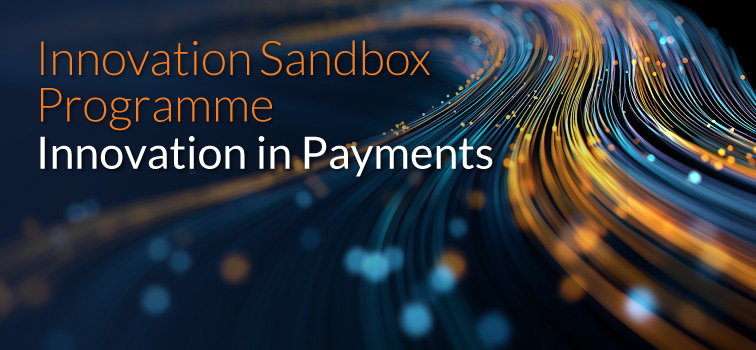Innovation Sandbox Programme — Innovation in Payments

Digitalisation is one of the most powerful “mega-trends” shaping our society and economy. With the rise of digital assets, surging transaction volumes, diversifying payment methods, growing market demands, and evolving business models in recent years, we have seen the transformative potential of technology in the world of payments. Active exploration of new technologies and innovations is also an important enabler for incumbent financial institutions to better understand their benefits and risks, consider the implications for their business models, and prepare for the future.
Payments are the lifeblood of the economy, and innovation in payments – done well and safely – can unlock broader economic benefits. They can improve efficiency, enhance competition, and reduce costs for businesses and households.
As a central bank, we are deepening our understanding of the opportunities and risks of different technologies and innovations. Our ultimate aim is to ensure that the benefits of innovation for consumers of financial services are realised and that the risks are managed effectively, thereby maintaining confidence in money and payments throughout this ongoing transition.
Our Innovation in Payments Sandbox provides an opportunity to take a strategic lens to the future of payments and expand the partnership between the public and private sectors in order to achieve optimal outcomes for households and businesses. The objective is to accelerate solutions that deliver safer, faster, greener and more inclusive payments for households and businesses, while giving the Central Bank early insight into emerging risks and supervisory questions.
FAQ
Central Bank of Ireland has developed an Innovation Sandbox Programme to inform the early stage development of selected innovative initiatives that promote better outcomes for consumers and the financial system. Through the programme, we aim to provide regulatory advice and support to firms on their innovative projects, in line with our public policy objectives.
What is the framework for the current Sandbox theme “Innovation in Payments”?
Our current Sandbox Programme takes the thematic approach of “Innovation in Payments”.
The programme operates on a cohort basis over six months to allow the innovation to develop.
The programme will encourage collaboration across the ecosystem. Programme outputs will be documented with shared learnings. The programme also aims to facilitate the development of new ventures and new business models that solve challenges identified in the sandbox theme, and to facilitate the faster and safer deployment of substantially new technologies, products, or services.
The Sandbox Programme framework for Innovation in Payments comprises:
- A structured programme of workshops
Participants will engage in workshops on specific topics relevant to the theme. The topics will be relevant to participants and tailored to their needs and requirements as much as possible. - Dedicated support
Each participant will engage regularly with their dedicated Sandbox Relationship Manager, who will act as their point of contact to oversee and coordinate participation throughout the programme. The Sandbox Relationship Manager will also liaise with a broad range of internal Central Bank subject matter experts to provide comprehensive regulatory advice and support as necessary. - Data Tools
Each participant can access a Data Platform offering data sets and tools relevant to the theme so that they can test and develop their innovation.
The methodology and delivery of this programme will be subject to continual assessment and impact review.
- Inclusive Access to the Digital Economy
How can everyone confidently engage in the digital economy?
The rapid shift to digital payments is transforming how people access and manage money, yet some consumers – including those
in vulnerable circumstances – remain excluded. Limited access and unintuitive user experiences prevent segments of society from participating fully in the digital economy, creating barriers to financial inclusion and financial wellbeing.
- Frictionless and Transparent Money Movement
How can payments be made seamless, transparent, and efficient to benefit both consumers and businesses?
Consumers and businesses increasingly expect instant, low-cost payments that work seamlessly
across banks, providers, platforms, and borders. Fragmentation can harm efficiency in payments, resulting in higher costs for businesses and households. Creating interoperable, real-time payment systems with full transparency on costs, speed,
and settlement can deliver greater control, confidence, and efficiency. - Resilient and Secure Payments
How can payments be strengthened to reduce fraud, ensure integrity, and enable faster, safer, and more accessible payments?
The expansion of digital and cross-border payments introduces greater risks of fraud,
cybercrime, and systemic instability. Harnessing advanced technologies – including AI, real-time monitoring, and collaborative fraud detection – can prevent threats before they affect consumers, reduce financial crime, and protect
the integrity of the financial system while enabling faster, more accessible payments. - Safe Integration of Emerging Payment Technologies
How can new technologies be safely adopted while protecting consumers and maintaining system-wide security and stability?
Emerging technologies and infrastructure – such as AI-powered financial
services, tokenised payments, and stablecoins – offer potential benefits, but can also introduce risks around privacy, interoperability, security, compliance, and consumer protection. Without careful integration, these innovations may undermine
financial stability and trust.
No. The programme does not provide any derogation or waivers from regulation to participants to engage in any testing of products with consumers, nor does it provide endorsements of any product, service or solution. However, when providing regulatory advice and support within the programme, we will seek to adopt a proportionate, outcome-focused and risk-based approach.
The programme is open to applications from all sectors of the financial system such as authorised incumbent firms, start-ups scaling innovation, fintechs seeking authorisation, technology businesses providing services to financial firms, and academic commercialisation projects. The programme is open to applications from standalone entities and from partnerships. The programme is not suitable for an innovation that is at a very early stage of development where, for example, a model has not yet been built. If in doubt, please contact us at [email protected] to discuss the programme in further detail. We can also discuss whether our Innovation Hub may be more suited to your needs.
Applicants do not have to be Irish domiciled. However, we do expect that applicants are selling, or intend to sell, their service or product in the Irish market.
Applications are sought from research projects that are focussed on the commercialisation of research. Commercialisation is the process of turning research into an innovative commercial product or service. Ideally, applicants should be able to demonstrate that they have developed their solution in line with trial partners/customers.
We do not help participants to find partners to participate in the programme, nor do we match participants together for projects. It is for each applicant to consider whether it needs to partner with another party in order to participate in the programme.
We expect participants to dedicate sufficient time and resources to engage with the Central Bank in a meaningful and timely manner throughout the full six months of the programme. We recommend that participants attend each of the workshops. We expect a sufficient level of subject matter expertise of the participants for information sharing and mutual learning purposes.
The provision of regulatory advice and support will provide participants with an understanding of the regulatory frameworks applicable to their specific innovation, covering a broad range of domestic and European regulations, standards, guidelines and supervisory expectations.
The provision of regulatory advice and support within the programme is not legal advice and is not a substitute for risk and compliance resources. It remains for each participant to determine how it will ensure compliance with relevant regulations, as applicable, and to demonstrate how it will meet regulatory standards and expectations.
The Central Bank can only give advice and support on the obligations within its mandate.
Participants should be mindful of the legal obligations applicable to them.
Applications will be assessed on the following selection criteria:
- The innovation should support consumers and/or the financial system and be clearly aligned with an Innovation Sandbox Programme Problem Statement.
- Compelling case showing the Sandbox Programme as essential to innovation development.
- Strong evidence of readiness across multiple areas (market, scale, revenue model) and readiness to engage with Innovation Sandbox Programme.
- Strong, credible team with relevant expertise, resources, and identification of supports where needed to develop innovation beyond the programme.
All content moved out of table for accessibility and user experience reasons.
Yes. At the end of each programme, the Central Bank will publish a report sharing key learnings from the programme. The report will include information on the thematic learnings and on the operation of the programme. In this way, the programme will not only benefit the participants, but the whole innovation ecosystem.
The closing date for applications to the Innovation Sandbox Programme on Innovation in Payments is 10 November 2025. A specific selection panel comprising Central Bank Directors and an external academic will make the final selection decision.
Selected applicants will be required to sign the Terms and Conditions before commencing the programme. Applicants that were not selected to participate will be informed of the Central Bank’s decision and provided with relevant feedback including details of the Innovation Hub, which may be a more suitable channel to consider their innovation.
Once selected, each participant will work with a designated Sandbox Relationship Manager to agree on objectives and liaise on workshop modules, the Data Platform and any questions the participant has.
We do not provide funding to participants.
There is no charge to apply to the programme. The overall cost of the resources deployed on the Sandbox activities are funded by the financial services industry as a whole. In line with the Central Bank’s overall industry levy approach, the funding of the programme is achieved in a proportionate and appropriate way across sectors and regulated entities.
Applications are now closed
